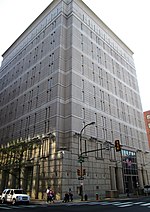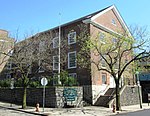Pennsylvania Hall (Philadelphia)

Pennsylvania Hall, "one of the most commodious and splendid buildings in the city," was an abolitionist venue in Philadelphia, Pennsylvania, built in 1837–38. It was a "Temple of Free Discussion", where antislavery, women's rights, and other reform lecturers could be heard. Four days after it opened it was destroyed by arson, the work of an anti-abolitionist mob. Except for the burning of the White House and the Capitol during the War of 1812, it was the worst case of arson in American history up to that date. This was only six months after the murder of Rev. Elijah P. Lovejoy by a pro-slavery mob in Illinois, a free state. The abolitionist movement consequently became stronger. The process repeated itself with Pennsylvania Hall; the movement gained strength because of the outrage the burning caused. Abolitionists realized that in some places they would be met with violence. The country became more polarized.
Excerpt from the Wikipedia article Pennsylvania Hall (Philadelphia) (License: CC BY-SA 3.0, Authors, Images).Pennsylvania Hall (Philadelphia)
North 6th Street, Philadelphia Center City
Geographical coordinates (GPS) Address Nearby Places Show on map
Geographical coordinates (GPS)
| Latitude | Longitude |
|---|---|
| N 39.9541542 ° | E -75.1495888 ° |
Address
American College of Physicians
North 6th Street
19106 Philadelphia, Center City
Pennsylvania, United States
Open on Google Maps









